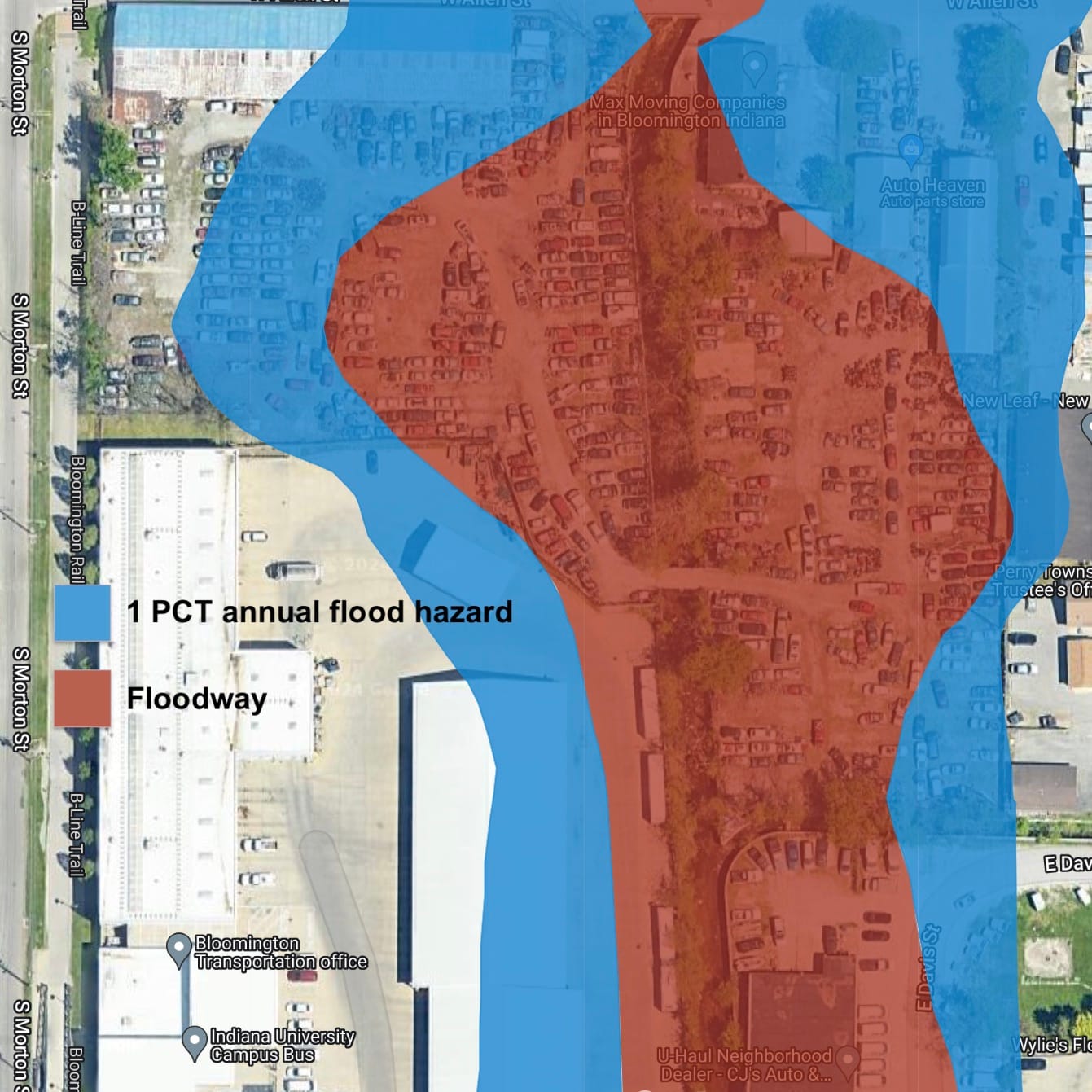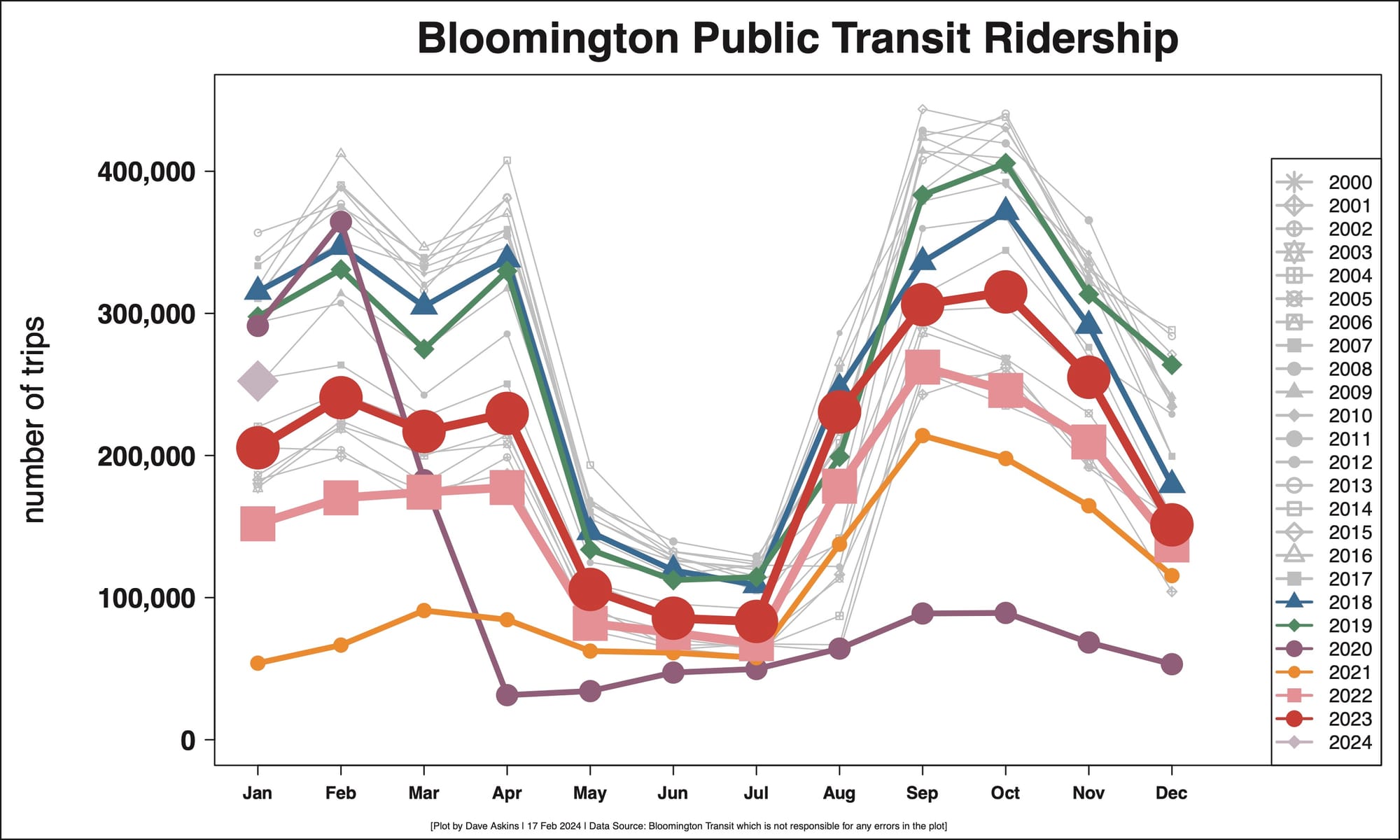Bloomington bus update: BT general manager against SB 52, floodway hinders on-site expansion




Bloomington Transit’s plan to expand its fleet, in support of offering cross-town east-west express service, is hitting some speed bumps—one due to natural conditions and another due to potential state legislative action.
On Tuesday, at its regular monthly meeting, the five-member Bloomington Transit (BT) board got an update on the issues.
The natural conditions are related to the fact that a good part of the existing property, where BT’s bus storage facility and administrative offices are located, sits in a floodway or floodplain. The same goes for immediately adjoining land, which ordinarily would be a logical possibility for acquisition and expansion.
But constructing inside bus storage, which is best for the battery electric vehicles that BT eventually wants to use for its entire fleet, would be challenging in a floodway as defined by FEMA (Federal Emergency Management Agency).
Another hurdle is a piece of legislation pending in this year’s state legislative session. Senate Bill 52 would prohibit local government units like BT, at least until July 1, 2025, from adopting or enforcing a any policy, that seeks to establish a dedicated bus lane.
SB 52 has been passed by the state senate on a 35–14 vote, and is being heard by the roads and transportation committee of the state house.
Any proposed east-west express route across Bloomington would likely include some combination of dedicated bus lanes for at least part of the route. At Tuesday’s meeting, general manager John Connell reported to the board on his turn testifying against SB 52 at the committee hearing, which took place earlier that day.
Meanwhile, BT’s fixed route ridership continues to claw its way back towards pre-pandemic numbers. The 252,380 fixed-route rides provided in January 2024 amounted to 84.7 percent of the January 2019 ridership figures.
Senate Bill 52
The video for the Feb. 20 house committee hearing, including Connell’s testimony, is available on the state legislature’s website.
In his brief remarks, Connell told the house committee members that in Bloomington there’s currently a study underway to explore the feasibility of an east-west express route that would go through the heart of the Indiana University campus.
The recommendation of that study, Connell told the committee, is anticipated to include segments of bus-only lanes on campus. The reason for bus-only lanes is not just to keep the buses running on time, but for passenger and pedestrian safety.
Connell put it like this: “If you’ve ever been on campus, during class changes, it can be chaotic—students scrambling about on foot, scooters, skateboards.” Dedicated bus lanes could reduce and possibly eliminate pedestrian-vehicle conflicts, Connell said. Connell told the committee that he is opposed to SB 52.
The bill was introduced, in large part to block the implementation at least for a year, of IndyGo’s planned Blue Line route, which includes dedicated bus lanes.
As Connell was leaving the public mic, committee chair Jim Pressel, who represents District 20, had a question for him: “So let me ask you this: Would you oppose Senate Bill 52, if it were amended to only include Marion County?”
Connell’s one-word answer: “Yes.” Pressel asked for confirmation: “You’d still oppose?”
Connell’s longer answer went like this: “I think the ramifications for the public transportation industry throughout the state would be very adverse, I think it sends a message to the Federal Transit Administration that the state of Indiana is not receptive to ambitious, bold, public transit investment.”
Land Acquisition
The 2024 budget for Bloomington Transit includes $12.5 million for land acquisition
The idea is to use about $2.5 million of local money to match a hoped-for federal grant that will cover the cost of the roughly $12.5-million project.
When several new battery-electric buses, which have already been ordered, start to arrive in Bloomington, BT will need more space—to store and do maintenance on them, than it currently has at Grimes Lane. The eventual need for more space has been recognized for a few years.
The real estate where the Grimes Lane facility sits is owned by Indiana University. Bloomington Transit and IU Campus Bus services are co-located there. So one of the strategies included in BT’s strategic plan, adopted early this year, is to expand opportunities for collaboration and integration with IU Campus Bus, beyond mere co-location.
At Tuesday’s meeting, in his report to the board on the topic of land acquisition, BT general manager John Connell said that the search for potential expansion sites had been expanded beyond the immediate vicinity of the current Grimes Lane facility. Connell, and the committee that is working on land acquisition, have directed BT’s real estate consultant, Hanson Professional Services, Inc., to expand its search to include any property within Monroe County’s urbanized area.
Zac Huneck, who is BT’s grants and procurement specialist, is working on a federal Section 5339 grant application to help pay for the property. Huneck said that it would help the application if the location were already identified.
The search parameters have been expanded, because it could be difficult or impossible to get permission to build in a FEMA floodway the kind of facility that BT would like to have.
Huneck said that even though the possible location had been expanded to include all of Monroe County’s urbanized area, the hope is to find some site that is centrally located, to reduce “deadhead miles”—the distance buses travel from their overnight storage location just to get to the point where the routes start and the vehicles can begin generating revenue.
Other factors to be considered, Huneck said, include the “ease of acquisition.” Publicly-owned land would make the transfer a lot easier, Huneck said. Another plus for any piece of real estate would be if the zoning for the land is already compatible with the intended use as a bus storage facility, and did not have to be rezoned, Huneck said. Other questions for any potential piece of land include: Is there utility infrastructure in place? and Are there any existing buildings on the property that can be repurposed?
The ideal parcel size would be 35 acres, Huneck said. That would probably be adequate for at least the next 50 years, he said. With the 5 acres for the current facility and the roughly 12 acres of immediately adjoining properties, that would come to just about half the ideal land area.
Huneck said that he will be meeting with representatives from the FTA (Federal Transit Administration) later in the week to talk about the land acquisition project.




Comments ()